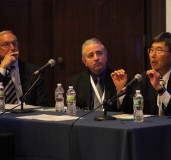Endometriosis Foundation of America
Endometriosis 2013 / The Impact of Research in the Clinical Practice
Maurice Abrao, MD
Thank you very much. Thank you Juan, I would like to thank Tamer for this invitation, and also C.Y. and Harry. I will try to share with you in the last few minutes what happened in Sao Paulo University in the Endometriosis Division in terms of the meetings that we had to improve the research and mainly because the Endometriosis Division was created in Sao Paulo University in 1991. At that time we realized that we had a large number of patients with pelvic pain waiting for laparoscopy. For sure, we needed to have criteria to decide properly which patient should benefit from surgery and how to choose the patients according to the severity of the disease. Or perhaps to try to be a little bit more clear in terms of this purpose.
When we think about the concept of the translational medicine everybody knows that its definition includes the concept that this translational medicine translates the scientific findings relevant to human disease into knowledge that benefits patients with the aim of optimizing patient care and preventative measures which may extend beyond health care services.
So, for these reasons we started in the 1990s to try to think better about the diagnosis of the disease. Of course, to think better includes good knowledge of the clinical, laboratorial and imaging aspects involved in the diagnosis of the disease to allow us to decide better who would need or not the laparoscopy. And for sure how to decide in terms of that long line that I commented upon before.
The first aspect of this was that our group in Sao Paulo studied a lot of clinical aspects of the disease. We started from the symptoms but included evidence like this that we published in 2003. This showed that the time elapsed from the onset of the symptoms of endometriosis and the diagnosis is about seven years. The younger the patient we have the higher a time to diagnose the disease. As you can see here when the symptoms start before 20 years old it may be more than 12 years to diagnose the disease. In the same way we also evaluated 2,000 patients in Sao Paulo University some time ago trying to identify some data that should be relevant in terms of differentiating patients with endometriosis and without endometriosis. We found some data like this one of race, of educational level, some symptoms like dysmenorrhea and non-cyclic pelvic pain, dyspareunia, deep dyspareunia, bowel symptoms, infertility and diarrhea. And for this we also proposed some time ago the hypothesis that we can use risk factors to calculate the odds ratio for patients to develop the disease as you can see here. For example, if the patient data includes all of this information here, she should have an eight times higher chance of developing the disease.
At the same time in the 1990s we evaluated some markers. We started working with some markers like the CA125 and in this publication in 1997 we observed that the best moment to measure the CA125 was the first, second or third day of the menstrual cycle. Unfortunately this marker or other markers like CA99, CEA or alpha-fetoprotein did not have the proper sensitivity to allow us to diagnose the disease well before the surgery.
Then we started in 1998 to study imaging related to endometriosis. We started with the transrectal ultrasound showing that it is feasible to use the transrectal ultrasound to detect deep endometriosis, mainly endometriosis compromising the rectum and the sigmoid. But of course the problem is that this is not a feasible exam for us to perform to indicate for public health proposals mainly because we are talking about a very prevalent disease. For these reasons we went a step back and started analyzing easier methods like transvaginal ultrasound and MRI. We have some publications showing exactly, like this, that sometimes the disease appears as just the tip of the iceberg. We can have a simple ultrasound with simple bowel prep, simple enema one hour before the exam to remove feces and gas from the rectum to allow us to diagnose before the surgery and to properly plan the surgery as everybody knows nowadays.
The other method that we also evaluated was the MRI and we observed that MRI is feasible also. It can provide us a pelvic map. But the problem is that MRI is not as good as transvaginal ultrasound for us to detect the layers of the rectum that are compromised by the disease. In this publication that we have from 2007 we found the sensitivity with transvaginal ultrasound was 98 percent for rectal endometriosis and 83 percent with MRI. When we talk about rectocervical disease we found a sensitivity of 95 percent, also better than MRI. This is why using this way of thinking about the disease, and trying to apply our thoughts about the need of non-invasive diagnosis, we nowadays define much better than in the 1990s about when to go to laparoscopy or not if we are talking about a patient with endometriosis and pain. We start with a clinical exam with some imaging methods. If we find normal results for imaging methods and combine it with the clinical exam we think that all these patients have early stages of endometriosis or she does not have the disease. For this reason we indicated starting clinical treatment if there is no improvement and then we indicate laparoscopy.
On the other hand, if we find ovarian lesions of more than 4 cm or signs of deep endometriosis we think that laparoscopy is indicated for this purpose.
When we talk about infertility we also start with a good clinical exam and imaging methods. If it is normal the same thing, or this patient does not have endometriosis or she has early stage endometriosis. Then we indicate ovarian stimulation and of course if she has an obstruction of the tubes, or she does not succeed with this ovarian simulation, we indicate laparoscopy after six months to one year. With findings of ovarian disease or deep endometriosis we can indicate laparoscopy, mainly if she has symptoms or of course we can look for other factors to help us to define properly how to proceed, like previous surgery for endometrioma at the age of more than 35 years old that may be helpful for decision.
Then also this information can also be useful for us, for example, to define procedures and advanced procedures like the decision of how to do bowel endometriosis. Again, using a clinical exam and a good imaging method we can define if the disease is compromising the rectum, is unifocal or multifocal. Then we indicate if there is a unifocal lesion compromising just the serosa or artery of the muscularis and we indicate another resection that can be easily performed with a circular stapler. As you can see here that is a safer mode to perform this kind of procedure. If we find a disease compromising the rectum multifocal or bigger than three cm in the longitudinal diameter for this situation, here we indicate a bowel resection that can be done of course by laparoscopy as you can see here.
On the other hand, if the patient does not have pain, or does not have relevant pain of more or less than seven individuals on a large scale, we indicate clinical treatment just to treat the pain and observe with imaging and clinical evaluation. We just indicate surgery for these cases when we find an increase of the nodule or if the patient starts developing pain.
Then also using this way of thinking we are, nowadays, after seeing more and more cases of endometriosis, mainly deep endometriosis, defining properly when to proceed. We have one of our research fields focused on minimally invasive diagnosis and we are looking at very nice collaborations for markers. And also we are trying to define other things that imaging can provide us before the surgery, like to define where the nerves or even to be helpful for us to detect disease in...on appendix or other important sites. Also, we are looking more and more in the last ten years for other research fields like immunology, like general mixed transcriptomics and epigenomics. Fibrosis, we are looking more and more for fibrosis nowadays and for the relation between endometriosis and cancer, and also, with some indications in the field of stem cells.
To conclude, to be sure have a research group that is very relevant in terms of a lot of aspects because, of course, we can learn from the evidence based medicine. It can be helpful for us to build a diagnostic and therapeutic strategy. By finding our passion and focusing on a field of interest it is possible to stimulate our growth and our capacity of building a team. Of course discuss with the patient before the surgery all of the possible findings that we may have. Avoid complications and also for medical legal reasons.
This is our team in Sao Paulo University. Also I would like to invite you to save the date for the World Endometriosis Congress next year from April 30th to May 3rd in Sao Paulo and also to attend the WISE meeting "Focus on Endometriosis" to be held in Orlando on August 4th and 5th in 2013.
Thank you very much.










